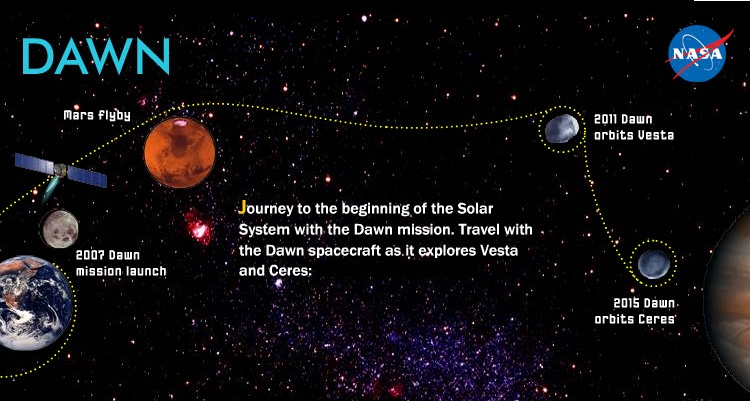[/caption]
The Dawn spacecraft’s three ion engines have done their work for now, and mission engineers shut down the frugal but powerful ion propulsion system on Thursday as scheduled. The spacecraft is now gliding toward a Mars flyby/gravity assist in February 2009. “Dawn has completed the thrusting it needs to use Mars for a gravity assist to help get us to Vesta,” said Marc Rayman, Dawn’s chief engineer from JPL “Dawn will now coast in its orbit around the sun for the next half a year before we again fire up the ion propulsion system to continue our journey to the asteroid belt.” The unique propulsion system will allow Dawn to travel to the asteroid Vesta in 2011, enter orbit around the asteroid, and then leave that orbit to head to orbit another asteroid, Ceres in 2015. This has never been accomplished before, and the ion engines make it all possible.
Dawn’s ion engines are vital to the success of the misson’s 8-year, 4.9-billion-kilometer (3-billion-mile) journey to asteroid Vesta and dwarf planet Ceres. Just one of these extremely frugal powerhouses can generate more than 24 hours of thrusting while consuming about .26 kilograms (about 9 ounces) of the spacecraft’s xenon fuel supply — less than the contents of a can of soda. Over their lifetime, Dawn’s three ion propulsion engines will fire cumulatively for about 50,000 hours (over five years) — a record for spacecraft.

Dawn’s ion engines may get a short workout next January to provide any final orbital adjustments prior to its encounter with the Red Planet. Ions are also scheduled to fly out of the propulsion system during some systems testing in spring. But mostly, Dawn’s three ion engines will remain silent until June, when they will again speed Dawn toward its first appointment, with Vesta.
Vesta is the most geologically diverse of the large asteroids and the only known one with distinctive light and dark areas — much like the face of our Moon. Ceres is the largest body in the asteroid belt. By utilizing the same set of instruments at two separate destinations, scientists can more accurately formulate comparisons and contrasts. Dawn’s science instrument suite will measure shape, surface topography, tectonic history, elemental and mineral composition, and will seek out water-bearing minerals. In addition, the Dawn spacecraft itself and how it orbits both Vesta and Ceres will be used to measure the celestial bodies’ masses and gravity fields.
Source: NASA


SOOOO why aren’t we integrating this tech into commercial cars ?
Dawn’s supply of liquid xenon is about 425 kg from what I’ve been able to find and would take up about 142 litres of space. According to one website liquid xenon costs about US$10 per litre so the cost to fill up Dawn’s gas tank is about US$1420 and this will get it about 6.3 billion kilometres of mileage. That works out to 2.3 L / 100-million km. The 0.24 kg used in 24 hours (as Nancy suggested above) works out to be about 0.087 L (87 ml), our about 1/4 of a pop can.
My Toyota Matrix can go about 600 km on a 50 L tank of gasoline (or about 8.3 L/ 100 km) at a current price of about CA$1/L. So for me to drive for 24 hours (about 2000 km) I would use about 165 L of gasoline.
So for me to drive to Ceres it would cost me about CA$525-billion (or about US$420-billion) and would take me about 8630 years and use 525-billion litres of gasoline.
So I would say that NASA is getting their time and money out of Dawn! 😉
oops. I did mean to write 0.26 kg in 24 hours! The 87 ml figure is based on 0.26 kg!
Unfortunately, if you used ion propulsion tech in cars they’d have 0-60 acceleration measured in years rather than seconds, and I for one don’t want to wait that long to get home from work. To get high efficiency, Dawn’s engines sacrifice specific impulse (the 0-60 part).
“To get high efficiency, Dawn’s engines sacrifice specific impulse (the 0-60 part).”
Actually the specific impulse is quite high. The ion engines however lack thrust, making them unsuitable for automobile use.
formulaterp,
You’re absolutely right, it’s the high specific impulse that make’s ion power so cool. I just slipped a groove for a moment…
Actually the thrust of the ion engine is so low, that it could not move a car on the surface of the Earth at all, due to static frictional forces.
However, it would cause the car to lean forward a bit, but you’d need some pretty fancy equipment to detect that – assuming we had equipment sufficiently sensitive!
-Nivag
“Aye, Captain! Ion drive… we could learn a thing or two from that one”